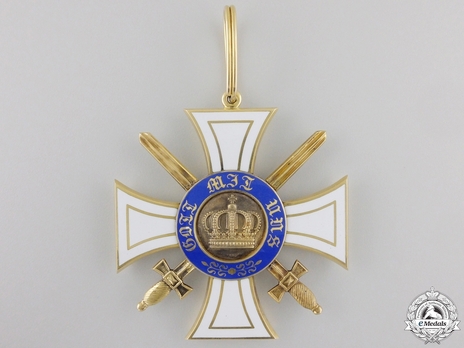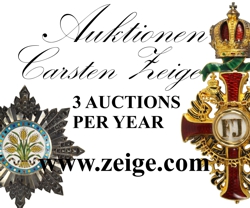Order of the Crown, Military Division, Type II, I Class Cross
SKU: 01.PRU.0110.201.01
Estimated market value:




Estimated market value:
Attributes
History
The Order of the Crown was founded by King Wilhelm I on the day of his coronation. It was awarded in recognition of civil and military merit.
The introduction of a new order offered the opportunity to settle issues of rank and equality, following the takeover of the House Order of Hohenzollern under the royal Prussian orders in January of 1851. In 1861, designs for a Wilhelm Order were presented, however, the prince regent changed the name to the Royal Crown Order.
The order originally featured a I Class Cross with I Class Breast Star, II Class Cross with II Class Breast Star, III Class Cross, and IV Class Cross.
Through the order's history, there were three different crown models featured on the obverse medallion of the order awards.
From 1861 to 1862, the awards featured a tall "heraldic" crown, similar to the Austrian crown.
From 1862 to 1868, the awards featured a small and round crown.
From 1869 to 1916, the awards featured a large crown.
There were many attributes added to the order grades.
In 1862, the king decided that all foreigners who deserved the awards who did not already have the Red Eagle Order would be awarded the Order of the Crown in the deserved class. If the foreign recipient did have the Order of the Red Eagle, they would receive the Order of the Crown in the next higher deserved class.
On March 27, 1863, all order grades could be awarded with jubilee dates. For I Class Stars, the '50' was to be placed directly above the medallion. The jubilee date corresponds to the Landwehr celebrating the 50th anniversary of its founding. It was also chosen to incorporate the jubilee date, as it was used on the Order of the Red Eagle, and the king desired these two orders to be equal. The award of higher anniversary dates is possible as well, being '60', '65', and '70'.
On February 27, 1864, crossed swords, through the centre of the cross and on the ring, could be conferred upon awards for military and war merit. These were incorporated to increase the equality of the Order of the Red Eagle. The decorations with swords were largely introduced because of the German-Danish War of 1864.
When a recipient of a civil award was then awarded a military award, it was to be worn on a black ribbon with white edging. If a recipient of a military award had already been awarded a decoration with swords, they were then to wear the higher class on a ribbon with two black and three white stripes. Military senior officials who were awarded the award with swords for performing duties under enemy fire, wore the award on a white ribbon with black edging. If awarded a civil decoration, as they performed their duties while not in the line of fire, the decoration did not have swords, but was still worn on a white ribbon with black edging.
As of October 18, 1864, a miniature version of the St. John Cross could be added to order awards, which were conferred for the meritorious service of caring for sick and wounded military personnel during the German-Danish War of 1864 and the Austro-Prussian War of 1866.
Prior to 1865, decorations were worn on a dark cornflower blue ribbon (the favourite colour of the king), however this became a lighter medium blue from 1865 onwards.
On January 18, 1865, order grades could feature the enamelled ribbon of the Order of the Red Eagle surrounding the centre medallion. At this time, the statutes were altered and as such, if a recipient of the I Class Order of the Red Eagle was awarded the I Class of the Order of the Crown, he was to remove the Red Eagle star and wear the star of the Crown Order. However, the Crown Order was to have the enamelled ribbon of the Red Eagle, to make it clear he had been awarded both. The recipient would wear the cross of the order they were granted first, and the star of the order they were granted second.
Following the 1870/71 war, the state ministry proposed that people who had distinguished themselves should be awarded an existing medal that was modified for this purpose. The king decided that the III and IV Class of the Royal Crown Order, as well as the General Honour Badge should be worn on a white ribbon with six blacks stripes and a red edge. This would later be called the memory ribbon. However, in reality, on June 22, 1871, an enamelled red cross on the upper cross arm could be awarded on the III Class Cross and IV Class Cross for merit in voluntary nursing during the Franco-Prussian War.
In 1872, a total of eight decorations were awarded, including one I Class, three II Class with star, and four II Class. Most civil servants first received the IV Class of the Order of the Red Eagle, followed by the III Class of the Crown Order. Therefore it was rare for civil servants to receive the IV Class of the Crown Order.
In 1914, the small decoration for the I Class was introduced.
During the First World War, most awards were made to nationals, however, the last two were awarded to foreigners, one to Austria in 1917 and one to Bulgaria in 1918.
The Crown Order Medal is not a part of the order. It was approved on December 1, 1888, however it was known to have been awarded prior to this date. It was awarded to sub-servants of non-Prussian courts on the correct cornflower blue ribbon. As of 1889, the medal could also be awarded to foreign sub-employees. In 1893, it was allowed to be awarded to native civilians in German protected areas to recognize their good work.
The motto of the Order is "Gott mit uns”, which translates to "God with us”.
The Type I Order awards rarely featured the tall Austrian-like crown, and more often featured the small, round crown. While there is no period literature denoting a physical change, the split into types was denoted by Dr. Klietmann, who identified that decorations after 1888 had a different crown pattern. The second form was likely used in the beginning of the 1870s as well, as examples have been seen on a IV Class with Swords. Type I is therefore identified as 1861-1866.
The first decorations were made by court goldsmith Wagner in Berlin.
The first award with diamonds was not made until 11 years after the founding of the order. Decorations with diamonds were made by Johann Wagner & Sohn and J. Godet & Sohn only. According to the general order commission, when the order was dissolved in 1919/20, the diamond decorations were sold off. The diamond management of the protected area in South West Africa acquired the last 15 decorations for 1.33 million marks.
The Type II (1867-1918) order awards feature a larger crown which fills the central medallion.
The I Class Cross with Swords was awarded twice in 1871 to Royal Bavarian Generals of the Infantry von der Tann and Hartmann. During the First World War, there were 52 awards, five of which went to the navy. The swords were made of gold until 1916, after which they were made of silver gilt.
The I Class Cross with Swords on Ring often had swords made of 14 karat gold. In 1908, there were 36 living recipients. Prominent recipients include Bronsart von Schellendorf, Adjutant General to the Emperor and King, and von Hahnke, Field Marshal General, Adjutant General of the Emperor and King, Chancellor of the High Order of the Black Eagle.
The I Class Cross with Swords and the enamelled ribbon of the Order of the Red Eagle was awarded for the first time in 1871 to Freiherr von der Tann, Royal Bavarian General of Infantry, and von Hartmann, Royal Bavarian General of Infantry. The awards with the enamelled ribbon of the ORE were all discontinued in 1888.
The I Class Cross with Diamonds with the enamelled ribbon of the ORE was in use from 1872 to 1888. By 1888, there had been a total of five I Class Crosses awarded with diamonds, however the order commission for the enamelled ribbon of the ORE was not specified separately.
The I Class Cross with Oak Leaves and the enamelled ribbon of the ORE was awarded eleven times between 1867 and 1871, including seven to high civil servants and four to generals.
The I Class Cross with Swords, Oak Leaves, and the enamelled ribbon of the ORE was awarded between 1867 and 1888. In 1871, there were eight awards made, exclusively to Prussian generals.

Versions
$5,200 USD
Gold/Enamelled
Obv: GOTT MIT UNS Rev: WR DEN 18 OCTOBER 1861
62x62mm
The Type II (1867-1918) Order awards feature a larger crown that fills the central medallion.
$4,700 USD
Silver gilt/Enamelled
Obv: GOTT MIT UNS Rev: WR DEN 18 OCTOBER 1861
62x62mm
The Type II (1867-1918) Order awards feature a larger crown that fills the central medallion.
$8,500 USD
Gold/Enamelled
Obv: GOTT MIT UNS Rev: WR DEN 18 OCTOBER 1861
61mm
The Type II (1867-1918) Order awards feature a larger crown that fills the central medallion.
N/A
Silver gilt/Enamelled
Obv: GOTT MIT UNS Rev: WR DEN 18 OCTOBER 1861
64mm
The Type II (1867-1918) Order awards feature a larger crown that fills the central medallion.
$6,200 USD
Gold/Enamelled
Obv: GOTT MIT UNS Rev: WR DEN 18 OCTOBER 1861
60-63mm
The Type II (1867-1918) Order awards feature a larger crown that fills the central medallion. This example was sold by eMedals for $6,500...
N/A
Gold/Enamelled
Obv: GOTT MIT UNS Rev: WR DEN 18 OCTOBER 1861
60-63mm
The Type II (1867-1918) Order awards feature a larger crown that fills the central medallion.
N/A
Gold/Enamelled
Obv: GOTT MIT UNS Rev: WR DEN 18 OCTOBER 1861
60-63mm
N/A
Gold/Silver/Enamelled
Obv: GOTT MIT UNS Rev: WR DEN 18 OCTOBER 1861
Johann Wagner & Sohn, Berlin
The Type II (1867-1918) Order awards feature a larger crown that fills the central medallion.
N/A
Gold/Enamelled
Obv: GOTT MIT UNS Rev: WR DEN 18 OCTOBER 1861 Suspension: 50
60-63mm
The Type II (1867-1918) Order awards feature a larger crown that fills the central medallion.This version featured the jubilee number on ...
N/A
Gold/Diamonds/Enamelled
Obv: GOTT MIT UNS Rev: WR DEN 18 OCTOBER 1861
64x64mm
The Type II (1867-1918) Order awards feature a larger crown that fills the central medallion.
N/A
Gold/Diamonds/Enamelled
Obv: GOTT MIT UNS Rev: WR DEN 18 OCTOBER 1861
64x64mm
The Type II (1867-1918) Order awards feature a larger crown that fills the central medallion.


Comments
Sign in to comment and reply.


Scroll Top